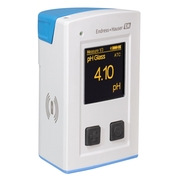About oxygen sensors and transmitters
The measurement of dissolved oxygen is essential for quality assurance and process control in numerous applications such as aeration control, fermentation or inertization. We provide instruments for reliable and accurate oxygen analysis over all measurement ranges from oxygen traces to high oxygen concentrations and for all conditions such as hazardous areas or hygienic processes. Check out our broad offering of dissolved oxygen sensors and transmitters by clicking on the button below.
How to select oxygen sensors
Oxygen sensors and transmitters are used in many industries such as water, wastewater, chemicals, power, life sciences, pharma, food & beverage and fish farming. The sensor selection depends on your preferences: amperometric oxygen sensors measure accurately and linearly from oxygen traces up to high oxygen concentrations. However, they do require regular maintenance. The advantages of optical oxygen sensors are the fast availability of stable measured values and extremely low maintenance.
The concentration of oxygen dissolved in a liquid can be measured using the amperometric or optical measuring principles. This video shows what it is about and how these measuring principles work.
Oxygen measurement with amperometric sensors
Amperometric oxygen probes comprise a working electrode and a counter electrode. They are surrounded by an electrolytic liquid in a common chamber and a direct voltage is applied to both. Oxygen permeates from the medium into the electrolyte through a membrane and is converted to a current at the working electrode. The counter electrode keeps the system running by means of a chemical equivalence reaction. The resulting current is proportional to the oxygen partial pressure in the medium.
Oxygen measurement with optical sensors
Optical oxygen probes use the fluorescence quenching method and feature an LED, a photodiode and a separating section to the medium that is covered by an oxygen-permeable layer. The layer contains marker molecules that are excited by an orange light and respond with a dark red fluorescence light. Oxygen molecules attach to the marker molecules and attenuate (quench) the fluorescence light. The photodiode then detects the light intensity which reflects the oxygen partial pressure in the medium.
Compensation of electrode aging or LED aging
Over the time each oxygen sensor can suffer from aging effects leading to measurement drifts:
- The counter electrode of amperometric probes can be covered with a silver bromide layer that reduces the effective voltage.
- The measurement LED of optical probes can lose its intensity.
To compensate these effects, we offer amperometric sensors with an additional reference electrode and optical sensors with a reference LED. This way, our sensors deliver accurate and reliable values over a long period.
Benefits
- We offer oxygen sensors and transmitters that meet all requirements from basic functionality up to multichannel and multiparameter measurement.
- Our oxygen transmitters process the measuring signal of each oxygen sensor and display it as you prefer: as oxygen partial pressure, oxygen concentration or oxygen percentage saturation.
- To provide you with full flexibility, our dissolved oxygen probes are designed both for use in channels and basins as well as for installation in pipes and tanks.
- Choose between a wide range of oxygen assemblies for all fields of applications: fixed installation assemblies, immersion assemblies, flow assemblies and retractable assemblies.
- Easy to use oxygen calibration standards help you to reliably adjust, calibrate and verify your sensors and to determine the zero point of each oxygen sensor.



















